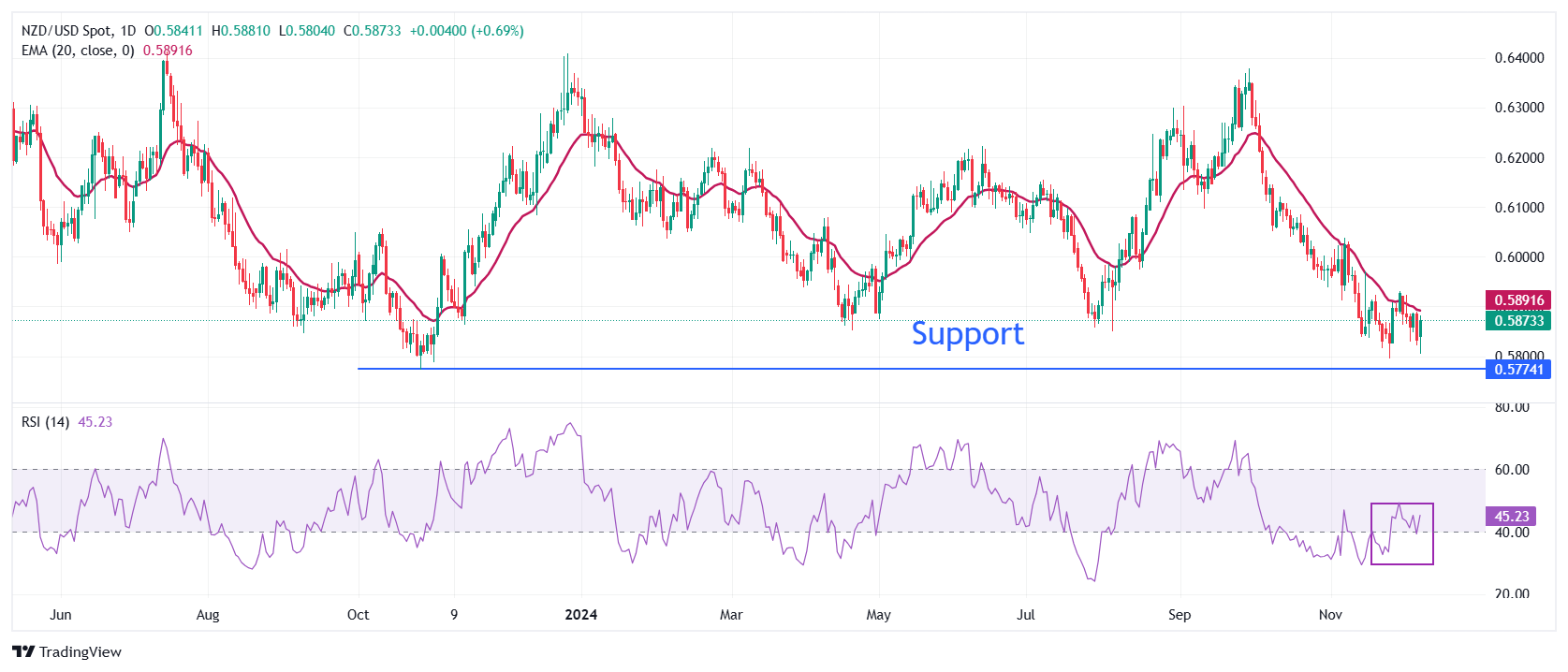- NZD/USD recovers sharply to near 0.5870 as China’s Politburo supported expansionary monetary and fiscal policies.
- The RBNZ is expected to cut interest rates again by 50 bps.
- Investors await the US CPI data for fresh interest rate guidance.
The NZD/USD pair rebounds strongly to near 0.5870 in the North American trading session on Monday after testing the annual low of 0.5800. The Kiwi pair jumps higher as the New Zealand Dollar (NZD) strengthens after China’s Politburo vowed to implement “more proactive fiscal policy and moderately loose monetary policy.” A scenario that will boost stimulus and allow the economy to achieve its economic targets.
It is worth noting that New Zealand is one of the leading trading partners of China and a boost to economic stimulus is favorable for the New Zealand Dollar.
Domestically, the outlook of the NZD remains weak as the Reserve Bank of New Zealand (RBNZ) is expected to continue with its aggressive policy-easing stance. The RBNZ reduced its Official Cash Rate (OCR) by 50 basis points (bps) to 4.25% in its monetary policy meeting on November 27 and guided for a similar rate cut pace if economic conditions continue to evolve as projected.
Meanwhile, the US Dollar (USD) consolidates, with investors focusing on the United States (US) Consumer Price Index (CPI) data for November, which will be released on Wednesday.
NZD/USD finds temporary support near 0.5800, while the 20-day Exponential Moving Average (EMA) near 0.5930 continues to act as a major barricade for the NZD bulls. The 14-day Relative Strength Index (RSI) rebounded after conditions turned oversold and climbed above 40.00, suggesting that the bearish momentum has faded. However, the bearish trend has not extinguished.
The Kiwi pair is expected to decline to near the October 2023 low at 0.5770 and the round-level support of 0.5700 if it retreats below 0.5820.
On the contrary, an upside move above the November 15 high of 0.5970 will drive the asset toward the psychological figure of 0.6000 and the November 7 high of 0.6040.
NZD/USD daily chart
New Zealand Dollar FAQs
The New Zealand Dollar (NZD), also known as the Kiwi, is a well-known traded currency among investors. Its value is broadly determined by the health of the New Zealand economy and the country’s central bank policy. Still, there are some unique particularities that also can make NZD move. The performance of the Chinese economy tends to move the Kiwi because China is New Zealand’s biggest trading partner. Bad news for the Chinese economy likely means less New Zealand exports to the country, hitting the economy and thus its currency. Another factor moving NZD is dairy prices as the dairy industry is New Zealand’s main export. High dairy prices boost export income, contributing positively to the economy and thus to the NZD.
The Reserve Bank of New Zealand (RBNZ) aims to achieve and maintain an inflation rate between 1% and 3% over the medium term, with a focus to keep it near the 2% mid-point. To this end, the bank sets an appropriate level of interest rates. When inflation is too high, the RBNZ will increase interest rates to cool the economy, but the move will also make bond yields higher, increasing investors’ appeal to invest in the country and thus boosting NZD. On the contrary, lower interest rates tend to weaken NZD. The so-called rate differential, or how rates in New Zealand are or are expected to be compared to the ones set by the US Federal Reserve, can also play a key role in moving the NZD/USD pair.
Macroeconomic data releases in New Zealand are key to assess the state of the economy and can impact the New Zealand Dollar’s (NZD) valuation. A strong economy, based on high economic growth, low unemployment and high confidence is good for NZD. High economic growth attracts foreign investment and may encourage the Reserve Bank of New Zealand to increase interest rates, if this economic strength comes together with elevated inflation. Conversely, if economic data is weak, NZD is likely to depreciate.
The New Zealand Dollar (NZD) tends to strengthen during risk-on periods, or when investors perceive that broader market risks are low and are optimistic about growth. This tends to lead to a more favorable outlook for commodities and so-called ‘commodity currencies’ such as the Kiwi. Conversely, NZD tends to weaken at times of market turbulence or economic uncertainty as investors tend to sell higher-risk assets and flee to the more-stable safe havens.
Information on these pages contains forward-looking statements that involve risks and uncertainties. Markets and instruments profiled on this page are for informational purposes only and should not in any way come across as a recommendation to buy or sell in these assets. You should do your own thorough research before making any investment decisions. FXStreet does not in any way guarantee that this information is free from mistakes, errors, or material misstatements. It also does not guarantee that this information is of a timely nature. Investing in Open Markets involves a great deal of risk, including the loss of all or a portion of your investment, as well as emotional distress. All risks, losses and costs associated with investing, including total loss of principal, are your responsibility. The views and opinions expressed in this article are those of the authors and do not necessarily reflect the official policy or position of FXStreet nor its advertisers. The author will not be held responsible for information that is found at the end of links posted on this page.
If not otherwise explicitly mentioned in the body of the article, at the time of writing, the author has no position in any stock mentioned in this article and no business relationship with any company mentioned. The author has not received compensation for writing this article, other than from FXStreet.
FXStreet and the author do not provide personalized recommendations. The author makes no representations as to the accuracy, completeness, or suitability of this information. FXStreet and the author will not be liable for any errors, omissions or any losses, injuries or damages arising from this information and its display or use. Errors and omissions excepted.
The author and FXStreet are not registered investment advisors and nothing in this article is intended to be investment advice.
Recommended content
Editors’ Picks

EUR/USD loses momentum to near 1.0300 ahead of Eurozone Retail Sales release
The EUR/USD pair trades in negative territory for the third consecutive day around 1.0310 during the early European session on Thursday. The downbeat German November Factory Orders and the expectation of aggressive rate cuts by the European Central Bank this year weigh on the Euro against the Greenback.

GBP/USD trades near 1.2350 after rebounding from nine-month lows
The GBP/USD pair remains under pressure for the third consecutive session, hovering near 1.2360 during Thursday's Asian trading hours. Technical analysis of the daily chart highlights a prevailing bearish bias, with the pair falling back to the descending channel pattern.

Gold price sticks to modest intraday losses amid bullish USD; downside seems limited
Gold price snaps a two-day winning to a multi-week top amid the Fed’s hawkish stance. Retreating US bond yields undermine the USD and lend some support to the XAU/USD pair. Traders look to Fed speakers for some impetus ahead of the US NFP report on Friday.

BNB poised for a decline on negative Funding Rate
BNB price hovers around $696.40 on Thursday after declining 4.58% in the previous two days. BNB’s momentum indicators hint for a further decline as its Relative Strength Index and Moving Average Convergence Divergence show bearish signals.

Bitcoin edges below $96,000, wiping over leveraged traders
Bitcoin's price continues to edge lower, trading below the $96,000 level on Wednesday after declining more than 5% the previous day. The recent price decline has triggered a wave of liquidations across the crypto market, resulting in $694.11 million in total liquidations in the last 24 hours.

Best Forex Brokers with Low Spreads
VERIFIED Low spreads are crucial for reducing trading costs. Explore top Forex brokers offering competitive spreads and high leverage. Compare options for EUR/USD, GBP/USD, USD/JPY, and Gold.
